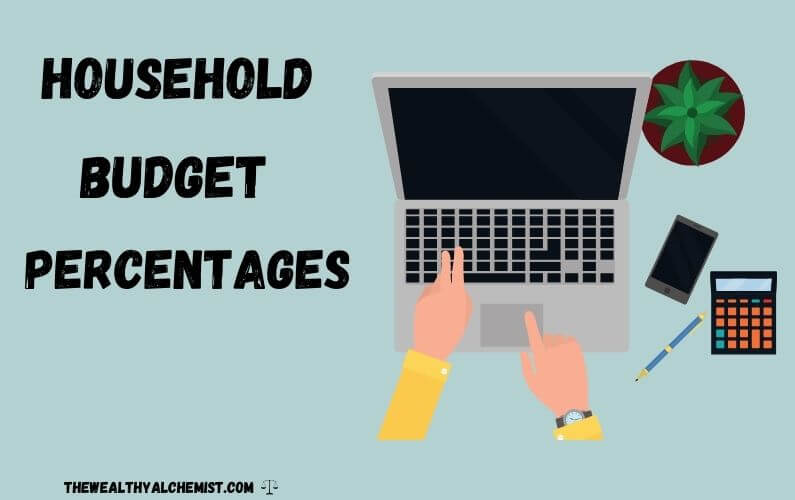
You may be wondering what’s the deal with household budget percentages. They have a lot in common with traditional budgets, but they’re more focused on the big picture.
Think about it like this. When payday arrives, many people have their spending planned down to the last dollar. The electricity bill is $76, the rent is $1,200, they’ve set aside exactly $150 for food, and so on… This is called traditional or zero-based budgeting.
But despite our amazing budgets, we start to lose control of our money.
Why? Because when we plan our spending down to the last dollar, anything we spend off-budget will throw a monkey wrench in our finances. And there’s always something that we didn’t budget for!
So, are we doomed to eternal financial failure?
No! The solution is to focus less on the details and more on the big picture using household budget percentages…
Contents
- 1 What are Household Budget Percentages?
- 2 Household Budget Percentages vs Traditional Budgeting
- 3 How to Create Budget Categories?
- 4 What is The Ideal Household Budget?
- 5 Recommended Budget Percentages – Dave Ramsey Version
- 6 50/30/30 Budget Categories?
- 7 Importance of Your Budgeting Plans
- 8 How do I Calculate My Household Budget Percentages?
- 9 Apps You Can Use For Following up on Your Budget
- 10 How do I Correct My Budget Percentage if I Overspend?
- 11 What’s Next After Budgeting?
What are Household Budget Percentages?
Household budget percentages are guidelines for spending your money.
Unlike traditional budgets which specify a dollar amount for each budget category, household budget percentages allocate a percentage of your income to each budget category.
For example, if your monthly family budget looks like this:
- 20% of income for food and personal supplies,
- 50% for housing and utilities
- 5% for entertainment
- and so on…
you’re using household budget percentages.
On the other hand, if you limit your spending to specific dollar amounts, like
- $300 for food or
- $1,200 for rent
- $100 for entertainment
you’re using a traditional zero-based budget.
Household Budget Percentages vs Traditional Budgeting
Whichever budgeting method works for you is a good budgeting method. But a percentage budget has a few advantages that make it great for beginner budgeters.
- Percentage-based budgeting methods are less detail-oriented,
- They’re less restricting, and
- They make it easier to benchmark your spending
Let’s go through each of these advantages one by one.
Percentage-Based Budget Plans Are Less Detailed
Traditional budgets tend to be very detailed, with a budget category for groceries, restaurants, car payment, health insurance, electricity, clothing, and dozens of other things!
Why? Because traditional budgets get your spending under control by dictating exactly where and how you can spend every dollar.
This is great if it works for you! But it can be a lot of work to keep track of!
On the other hand, percentage-based budgets don’t say exactly where each dollar gets spent. Instead, they provide general guidelines.
Why do they do this? Well, imagine creating a percentage-based budget where
- 2% of your paycheck is for restaurants
- 3% is for electricity
- 2% is for clothes
- and so on…
That level of detail would be harder to track than a traditional budget and would make your percentages-based budget useless!
Household budget percentages work best as guidelines that tell you where to spend large chunks of your paycheck. For example, 20% here, 30% there…
That’s why percentage budgets are less detailed and easier to follow.

Household Budget Percentages Are Less Restricting
Since budgeting with percentages is less detailed, that means they’re less restricting too.
With a traditional budget, you limit yourself to an exact dollar amount for each budget category. And then, if you don’t stick to it, you feel like a failure!
But with a percentage-based budget, you’re not limiting yourself to precise dollar amounts. Instead, you’re creating general guidelines on how to spend your money.
Another way to think of it is like this…
Traditional budgets are like the mom who tells you to “go outside and play catch”. But don’t leave the backyard and be back inside by precisely 3:00 pm. You’re told exactly what to do, exactly where to be and exactly when to stop.
You’ve got a lot of rules to follow and it’s easier to get in trouble for breaking one.
On the other side of things, budget by percentage is like the mom that says “go outside and play”, but just don’t leave the neighborhood, and be back inside before evening. The instructions are there, but it’s far less restricting.
And since you have much more freedom, you’re more likely to not break the rules.
[convertkit form=1640342]
Percentage-Based Budgets Allow Benchmarking
Benchmarking is when you compare your performance to a standard. For example, if you compare your spending to Dave Ramsey’s budgeting recommendation…you’re benchmarking.
And benchmarking is only possible when you use percentages.
Besides that, benchmarking also lets you track your own spending over time. Let’s say that today you spend 10% of your income on groceries, but next year to calculate that 20% of your income is going to groceries.
That might indicate a spending problem. Either way, benchmarking your current spending against your past spending is a great tool for keeping your expenses under control.
Related Post: How to Create a Budget to Succeed Financially
How to Create Budget Categories?
Now that you have an idea of what household budget percentages are their benefits, let’s talk about how to create your household budget categories!
You don’t need to be a numbers person, you just need to know how much income you have coming in every month, and the general amount you need (or want) to spend in each budget category.
Know Your Income
To start creating your household budget, you need to know your net income. Let’s say you make $3,000 a month. That $3,000 will be the denominator when calculating your budget percentages.
Make sure you use your after-tax income! The only number that will do you any good here is your net income after your taxes and deductions are taken out of your paycheck!
Group Your Expenses Into Categories
Remember, you don’t want to have a bazillion different categories in your percentage-based budget plan! So the more you can group similar expenses into one category, the simpler and easier it will be!
For example, instead of creating budget categories for rent, renters insurance, electricity, water, internet, etc….simply create one category called housing expenses.
Or to make it even simpler, just throw everything you have to pay for into a “necessities” category.
Know How Much You Need to Spend For Each Category
Take a minute to figure out how much you’ll need to spend in each category.
Once you’ve done that, your expenses will be the numerator when calculating your budget percentages. For example, if you need $1,000 for housing expenses every month, then your housing expense will be 33% of your budget ($1,000/$3,000).
Related Post: Who needs a budget? Everyone!

What is The Ideal Household Budget?
There is no recommended household budget that works for everyone.
Your ideal household budget will be unique to you and will depend on your income level, location, and family circumstances.
However, here is a general recommendation on how to allocate income in your budget.
- Housing – 25 – 35%. Includes budgeting for rent, insurance, and taxes.
- Food – 10 -15%
- Transportation – 10 – 15% (both public and private)
- Savings – Allocate 5 – 10% of your income for your future.
- Utilities – such as gas, internet, and cable allocate 5%.
- Medical – allocate at least 3% to medical needs above health insurance.
- Debt payments – let your debt payment range between 5-15% of your income. If the allocation is close to 23%, your budget might be a bit tight.
Again, it’s crucial you remember that these recommended household categories are just general guidelines on how to allocate your income.
Make sure you adjust the percentages based on your own needs.
However, even as you expand your options, make sure that you don’t spend more than you earn, and you aren’t forgetting to allocate some money to your savings.
Never downplay the importance of savings; they always come through when you encounter unforeseen expenses.
Recommended Budget Percentages – Dave Ramsey Version
The Dave Ramsey 7 baby steps have helped a ton of people save money, get out of debt, and build wealth. But Dave Ramsey also has his own recommended budget percentages.
- Health – 5-10%
- Entertainment/Recreation – 5-10%
- Utilities – 5-10%
- Food -10-15%
- Charity/Giving – 10-15%
- Savings – 10-15%
- Personal -10-15%
- Transportation: 10-15%
- Insurance: 10-25%
- Housing: 25-35%
There you have it! If you think Dave Ramsey’s budget percentages will work better for you, give it a try!
50/30/30 Budget Categories?
The 50/30/20 rule is another percentage-based budgeting plan. Unlike the Dave Ramsey budgeting recommendations, this plan only has 3 categories for budget!
The purpose of the 50/20/30 budget is to make budgeting and controlling your spending as simple as possible.
So, it allocates your after-tax income into only three recommended household categories.
- 50% for your needs,
- 30% on your wants, and
- 20% is for your savings
Related Post: How to Create a Budget to Succeed Financially
Needs (50%)
Your needs refer to the bills that you must pay and the things that are essential for survival. Expenses included in needs are housing payments, doctors visits and medicine, utilities, groceries, and minimum debt payments.
Dining out, paying for Netflix, and Starbucks are not needs (even though they sometimes feel like it!).
Wants (30%)
The money you allocate for wants is spent on non-essentials. Wants include vacations, purchasing movie and game tickets, those new shoes you’ve been eyeing for a while, and dining out.
You can do without your wants, such as cooking your food instead of eating out. Wants are the things that add entertainment to your life.
Savings (20%)
Under the 50/30/20 budget, 20% of your income should go to savings and debt payments. It’s also vital you set aside at least three months of emergency savings to take care of unexpected needs.
Importance of Your Budgeting Plans
As you can see, there are a few ways to go about creating your budgeting categories. Whether you start with the Dave Ramsey budget, or the 50/30/20 budget, or create your own, the important thing is to figure out what works for you!
And there are benefits to setting up your budget as well.
- It’ll help you get control of your finances
- You’ll stop living paycheck to paycheck
- Your budget will help you reach your financial goals
Budgets Help You Control Your Finances
A budget is a financial plan. It reflects the goals you want to achieve and shows how you’re going to get there. For example, your savings plan, debt payment plan, and sinking funds can all go into your budget.
Without that plan to guide your personal spending, you can quickly lose control of your money. And worse, when we splurge, we often can’t even remember what we spent our money on.
Do yourself a favor and set up your budget to get your personal finance under control!
It Helps You Stop Living Paycheck to Paycheck
If you didn’t get your next paycheck could you pay next month’s bills? If not, you’re living paycheck to paycheck.
And the first step to breaking out of that paycheck to paycheck cycle is to budget for savings and be disciplined about following your plan.
Once you build up enough savings so that you could pay next month’s bills with it, you’re technically no longer living paycheck to paycheck!
But the first step is to create a budget that you can stick to!
Use a Budget to Reach Your Goals
We all have financial goals. Whether it’s more money, less debt, or just something we’re saving up to buy. But we often dream about our goals without any real plan to make them happen.
Well, a budget can help here as well! Imagine that you need $1,000 to take a trip. What we usually do is sit around and hope the money drops into our lap.
But a better option is to set a hard date for your trip and allocate extra money to your monthly savings.
This will work for anything you need to save for!

How do I Calculate My Household Budget Percentages?
Now that you know the recommended budget percentages, you want to create your percentages. You are probably asking; how do I go about this? Well, the best way to go about this is through the guidelines we’ve gone through.
Create a list detailing where you spend your money. You can use the most common areas provided by the guidelines. Now, think of what your financial goals are. What do you want to prioritize in your budget?
Allocate the percentage according to your priorities. Once again, use the guidelines to estimate what percentage you allocate to each percentage.
Related Post: How to budget your money using 7 different techniques
Apps You Can Use For Following up on Your Budget
Personal Capital
A free app I use to track my monthly spending is Personal Capital.
To use Personal Capital all you need to do is link your bank card to the app. Every time you use your bank card to make purchases, Personal Capital will automatically track it.
Personal Capital then presents your personal finance information with graphs and charts to make it easy to understand.
Mint
Another free app that can track your expenses is Mint. Mint’s expense tracking feature works similar to Personal Capital’s. You simply link your debit or credit card to the app and it tracks your expenses as you spend.
It also has graphs and charts to make it easy to analyze your data.
Take a look at Mint here.
Empower
How do I Correct My Budget Percentage if I Overspend?
You may discover that you’re spending above the money you allocated to your household budgeting percentages.
The way to fix this is to monitor your spending (preferably with one of the apps mentioned above) and by cutting back wherever you can.
So what can you do to cut back? I’ve got four recommendations for you.
Use Cash instead of Credit/Debit Cards
Debit and credit cards are one of the biggest reasons we overspend today. There are even studies that show when we pay with plastic, we tend to spend more!
The way around this is to use cash! Take out whatever cash you need from the bank whenever you need to make a purchase. Because it’s inconvenient to go withdraw cash, you’ll end up spending less.
And when you do spend, because you’re paying with cash, you feel the pain of loss a lot more!
Use the Envelope Method
Another technique Dave Ramsey recommends is the envelope method. With this method, you get an envelope for each of your budget categories.
For example, one envelope could be for household supplies and food, another could be for your own personal spending…
Now allocate each envelope with the correct amount of cash. Remember, you don’t want to borrow from another envelope.
With all your envelopes filled with cash, put them in a safe location at home.
When you want to pay or buy anything, go to the envelope allocated for that item and retrieve your money.
Have no-spend Weekends or Find Alternatives
For a lot of us, Saturdays and Sundays are the biggest spending days. One technique to reduce your spending on these days is the no-spend weekend.
This simply means instead of going out and spending money, stay in, or find free alternatives.
You don’t have to make every weekend a no-spend weekend. Even if you only do it once or twice a month you’ll see some results!
Related Post: Who needs a budget? Everyone!
What’s Next After Budgeting?
You may find that one of the recommended household budgets works for you. Or you may end up creating your own budget percentages. But after that, it’s time to move to other financial goals.
Budgeting is just the beginning!
Now, you might want to start paying off debt or build your emergency fund into a full-blown savings account!
There are tons of tips out there on accomplishing these goals. One of the most famous is Dave Ramsey 7 baby steps to financial freedom, check out our post to learn more about them!
Who would have thought that learning about household budget percentages could be this fun? Now go ahead and create your budget and start your journey to achieving your financial goals!

Related Post: Complete guide to sinking fund categories
Idalmis
Latest posts by Idalmis (see all)
- Why Is Budgeting Important? 12 Best Reasons to Start Budgeting Today! - October 6, 2020
- How to be Frugal With Groceries. Must Try Tips! - September 15, 2020
- Is Skillshare Worth It? Best 2020 Review - August 31, 2020



